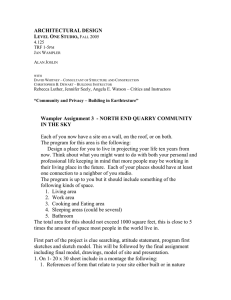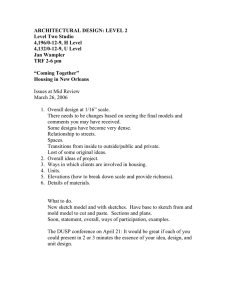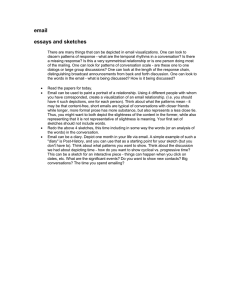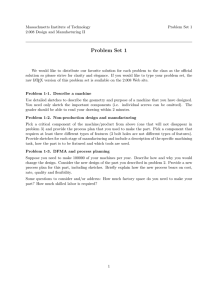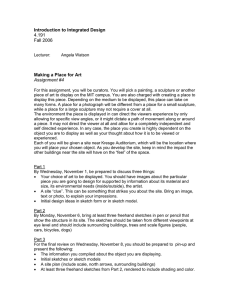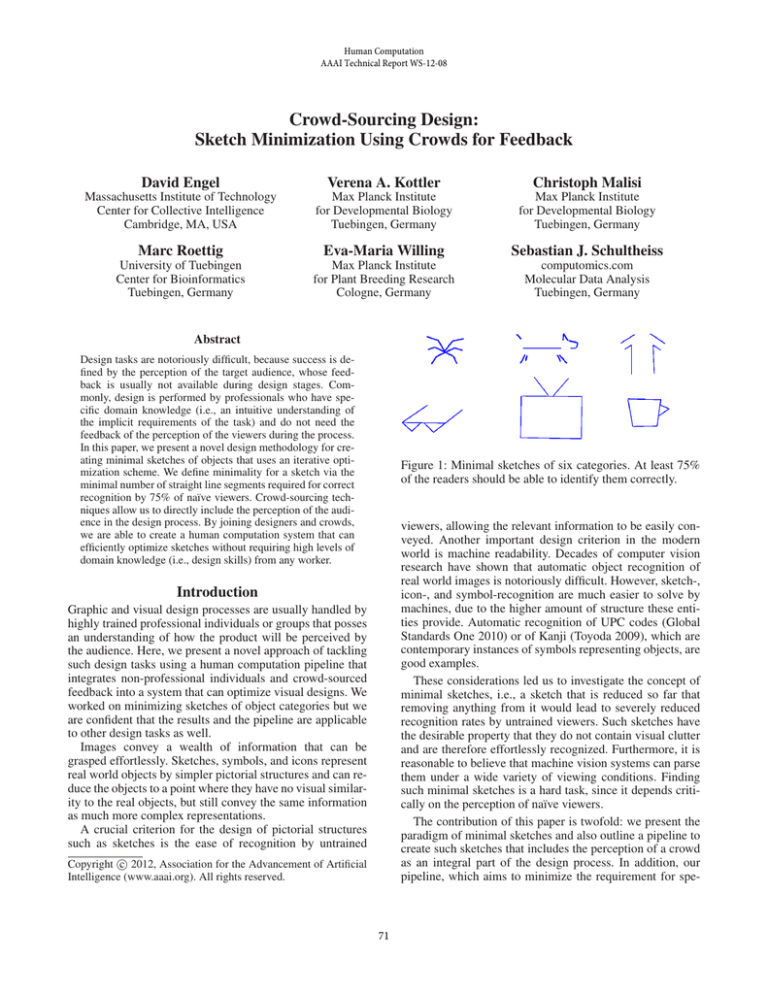
Human Computation
AAAI Technical Report WS-12-08
Crowd-Sourcing Design:
Sketch Minimization Using Crowds for Feedback
David Engel
Verena A. Kottler
Christoph Malisi
Massachusetts Institute of Technology
Center for Collective Intelligence
Cambridge, MA, USA
Max Planck Institute
for Developmental Biology
Tuebingen, Germany
Max Planck Institute
for Developmental Biology
Tuebingen, Germany
Marc Roettig
Eva-Maria Willing
Sebastian J. Schultheiss
University of Tuebingen
Center for Bioinformatics
Tuebingen, Germany
Max Planck Institute
for Plant Breeding Research
Cologne, Germany
computomics.com
Molecular Data Analysis
Tuebingen, Germany
Abstract
Design tasks are notoriously difficult, because success is defined by the perception of the target audience, whose feedback is usually not available during design stages. Commonly, design is performed by professionals who have specific domain knowledge (i.e., an intuitive understanding of
the implicit requirements of the task) and do not need the
feedback of the perception of the viewers during the process.
In this paper, we present a novel design methodology for creating minimal sketches of objects that uses an iterative optimization scheme. We define minimality for a sketch via the
minimal number of straight line segments required for correct
recognition by 75% of naı̈ve viewers. Crowd-sourcing techniques allow us to directly include the perception of the audience in the design process. By joining designers and crowds,
we are able to create a human computation system that can
efficiently optimize sketches without requiring high levels of
domain knowledge (i.e., design skills) from any worker.
Figure 1: Minimal sketches of six categories. At least 75%
of the readers should be able to identify them correctly.
viewers, allowing the relevant information to be easily conveyed. Another important design criterion in the modern
world is machine readability. Decades of computer vision
research have shown that automatic object recognition of
real world images is notoriously difficult. However, sketch-,
icon-, and symbol-recognition are much easier to solve by
machines, due to the higher amount of structure these entities provide. Automatic recognition of UPC codes (Global
Standards One 2010) or of Kanji (Toyoda 2009), which are
contemporary instances of symbols representing objects, are
good examples.
These considerations led us to investigate the concept of
minimal sketches, i.e., a sketch that is reduced so far that
removing anything from it would lead to severely reduced
recognition rates by untrained viewers. Such sketches have
the desirable property that they do not contain visual clutter
and are therefore effortlessly recognized. Furthermore, it is
reasonable to believe that machine vision systems can parse
them under a wide variety of viewing conditions. Finding
such minimal sketches is a hard task, since it depends critically on the perception of naı̈ve viewers.
The contribution of this paper is twofold: we present the
paradigm of minimal sketches and also outline a pipeline to
create such sketches that includes the perception of a crowd
as an integral part of the design process. In addition, our
pipeline, which aims to minimize the requirement for spe-
Introduction
Graphic and visual design processes are usually handled by
highly trained professional individuals or groups that posses
an understanding of how the product will be perceived by
the audience. Here, we present a novel approach of tackling
such design tasks using a human computation pipeline that
integrates non-professional individuals and crowd-sourced
feedback into a system that can optimize visual designs. We
worked on minimizing sketches of object categories but we
are confident that the results and the pipeline are applicable
to other design tasks as well.
Images convey a wealth of information that can be
grasped effortlessly. Sketches, symbols, and icons represent
real world objects by simpler pictorial structures and can reduce the objects to a point where they have no visual similarity to the real objects, but still convey the same information
as much more complex representations.
A crucial criterion for the design of pictorial structures
such as sketches is the ease of recognition by untrained
c 2012, Association for the Advancement of Artificial
Copyright Intelligence (www.aaai.org). All rights reserved.
71
Figure 3: Two minimal sketches of the category “Face” according to our definition. Both have the same number of
lines and both will be recognized correctly by at least 75%
of viewers.
Figure 2: A sketch of a mountain that could be recognized
in a multiple-choice question but not in a free-naming task.
to be easily recognized by machines as well. Restricting the
drawing tools is a good approach to address both constraints
since allowing arbitrarily shaped lines makes it nearly impossible to find a metric that compares the minimality of
two sketches (e.g. an Etch-A-SketchTM consists of a single
line but can be visually highly complex).
The most basic approach would be drawing single dots
and using the number of pixels as a metric for minimality.
However, this approach puts a high demand on the designer,
makes iterative minimization very difficult, and is not likely
to lead to machine recognizable sketches. We opted for the
most basic two-dimensional shape, a straight line segment.
All lines are of the same color and width. By only allowing lines, which are easily recognizable by machines (Duda
and Hart 1972), the resulting sketches have a good chance
of being machine-readable. We use the total number of lines
as our metric for minimality. On the one hand, we want the
sketches to be minimal, but on the other hand the sketches
also need still be recognizable by a high percentage of randomly chosen participants. Here, “recognizable” means that
the object category we want sketched should be the foremost word chosen to describe the sketch by at least 75% of
the viewers.
A simpler approach would consist of a categorization
task. In it, the participant would be asked whether the sketch
shows a certain object or not, thus steering the thought processes into this direction and priming the visual recognition
system. Such a task would allow too few lines in a sketch
defined as optimal (see Figure 2).
Our approach was to show the sketch to the participant
and ask for a one-word description in a free naming task.
With this, we make sure that the viewers really recognize
the sketch, rather than favourably interpret an oversimplified
abstraction of it when choosing between a small set of possible answers. In the end, we define a sketch as minimal if at
least 75% of viewers correctly recognize the object in a free
naming task and there is no other recognizable sketch with
fewer lines. This definition allows several different sketches
to be minimal at the same time (see Figure 3).
cial qualifications for the workers, could be applied to other
design tasks.
Related Work
Considerable work has been done on sketches. The earliest study relevant to this work has been done by (Snodgrass
and Vanderwart 1980), who present a set of 260 sketches of
common objects and a psychophysical evaluation of their
recognizability. These sketches were, however, only optimized for high recognition rates and are far from minimal
as defined here. Icon design is a related field and has attracted a lot of attention over the years (Calpin 2001). However, icons differ from sketches in being only symbolic representations rather than a depiction of the object and their
design has not been the object of much systematic research,
(e.g. (Chen 2003)). Much more research has been devoted to
the automatic recognition of sketches using techniques from
computer vision and machine learning, cf. e.g.(Mahoney and
Fromherz 2002); (Field et al. 2011); (Paulson and Hammond
2008). These approaches show that automatic sketch recognition systems are able to identify sketches correctly even in
suboptimal conditions.
Over the last years, the use of crowd-sourcing and microtask markets such as Amazon Mechanical Turk to harness
collective intelligence for complex tasks has seen a surge
in popularity. The idea of taking complex tasks and splitting them up in a large number of smaller tasks has led to
exciting work in, e.g., computer vision (Wah et al. 2011),
graphical perception (Heer and Bostock 2010), and biomedical research (Khatib et al. 2011). Most relevant to this paper is the work done in crowd creativity. (Yu and Nickerson
2011) had crowds combine, refine and evaluate designs of
chairs. Beyond that, (Yu and Sakamoto 2011) analyses the
crowd design process more closely. Furthermore, (Dow et
al. 2010) investigated an advertisement design task and the
factors that lead to better and more diverse results.
Experiment 1:
Iterative Sketch Minimization
Perceptually Optimal Sketches
Our goal is to create minimal sketches of object categories.
Minimality of sketches is difficult to define, especially under
the secondary constraint that we want the resulting sketches
During the usual design process, the designer has to predict
the perception of the target audience, which is a hard and not
72
Book
Window
Car
Fish
Shoe
Flower
Coffin
Mobile phone
Sun
Shirt
Woman
Computer
Airplane
Eiffel Tower
Vacuum cleaner
Letterbox
TV
Lamp
Fire
Tooth
Key
Glasses
Cup
Face
Bird
Spider
Dog
Alien
Brain
Rose
Table 1: Object categories from Experiment 1. The categories were selected to cover a wide array of objects.
Figure 4: A screenshot of the sketching tool.
easily quantifiable task. When designing our experimental
setup, we wanted to make the perception of the sketch an
integral part of the design process instead of keeping it a
separate stage at the end.
When asked to draw a minimal sketch, designers usually cannot judge well how many lines are required without
feedback from the perception of the viewers. We therefore
developed an iterative scheme, where sketching rounds (in
which the designers draw and optimize sketches) and recognition rounds (where a crowd of naı̈ve viewers names the
sketches) are interleaved. The categorizations of the viewers
are provided as feedback to the designers for the following
rounds. Our goal was the development of an automated process where the designer is led by the responses from participants of the recognition rounds. This scheme drastically reduces the requirements on the designers: they no longer have
to predict the perception of the audience. As professional designers may be biased by their prediction of the outcome, we
opted against using professionals for the experiment.
Figure 5: The optimization procedure used to generate the
minimized sketches. Designers and a crowd of naı̈ve viewers
iteratively create, rate and optimize the sketches.
The sketches can be exported in a text-based format that
lists start and end points of the lines on the canvas. Some
designers used this representation to straighten lines or align
them to each other. Sketches could also be imported again
using this format. We chose 30 common objects representing different categories (see Table 1 for a list of classes) for
which we wanted to obtain minimal sketches. These objects
cover a large set of classes, most of which do not yet have
a symbolic representation that is entrenched in the Western
culture.
Using the tool described above, we devised an iterative
procedure of interleaved sketching and recognition rounds
as depicted in Figure 5. In a sketching round, ten designers created sketches for half of the categories. The categories were randomly assigned to each designer. The resulting sketches were briefly presented to eight naı̈ve viewers in
Experiment design
The core element of the design rounds is a browser-based
tool that allows designers to draw sketches that adhere to
our constraints. The canvas was deliberately kept as simple
as possible and its only capabilities consist of drawing and
removing line segments, as well as moving their start and
end points. A screenshot of the tool is shown in Figure 4.
73
the recognition rounds. After a viewing time of just one second, the participants were asked to name the object that was
depicted in the sketch. The naming of a sketch had to consist
of one word and had to be a representative identifier for the
category.
In order to preserve naı̈veté, each viewer was presented
only once with each category. Since we had ten designers,
each drawing half of the categories, we had five sketches per
category. In a prefiltering step, we removed the two sketches
with the most lines from each category. Therefore, each
recognition round required twenty-four viewers (eight viewers for each of the three sketches). The responses from viewers were evaluated first via an automatic script that corrected
for spelling errors and synonyms of categories, while also
filtering adjectives (e.g., “plane” vs. “airplane” or “flower”
vs. “flwer” or “woman” vs. “old woman”). A sketch was
considered “correctly classified” if at least six of the eight
viewers named it correctly.
We iterated these steps by presenting the designers with
feedback about their sketches, i.e. the recognition rates, the
one-word responses as well as the sketches and recognition
rates for the sketches from the other designers. Given this
feedback they were given a chance to improve their sketches,
either by reducing the number of lines or by boosting recognition rates with added or altered lines. Because, of the time
it takes to gather the feedback for all the sketches the loop
was not interactive at this point.
Figure 6: Results from Experiment 1. The orange bars show
the average number of lines across all categories, and the
green bars show the average recognition rates.
Experiment 2:
Crowdsourced Sketch Optimization
In the previous Section, we described a method to obtain
minimal, perceptually valid sketches using crowds to provide feedback. In a second experiment, we take the next step
and aim to automate as much of the iterative design process as possible. For this, we are using workers from the
crowd-sourcing platform Amazon Mechanical Turk (AMT).
The nature of micro-task markets such as AMT requires the
posted tasks to be fairly small, to be easily explainable and
not to require any specialized domain knowledge. Consequently, we are not able to outsource the whole pipeline
but only parts of it. Specifically, the creative part in coming
up with valid starting points for the optimization requires a
considerable amount of creative effort, motivation and design capabilities and does not seem to be easily amendable
to AMT. Workers who were asked to create approximately
minimal sketches from scratch either used far too many or
too few lines and rarely returned useful sketches. However,
crowd-sourcing the remainder of the tasks is feasible and
leads to a much more favourable trade-off between the time
of the designers and the cost of the project.
Results
The most stunning result from the first experiment was the
small number of rounds it took to optimize the sketches to
our criteria. After only two rounds, most of the categories
were fully optimized. Most of the designers claimed they
could not reduce the number of lines any further without sacrificing recognition rate beyond the allowed cutoff. In some
cases, designers had already tried and failed with a lower
number of lines used for a sketch. In total, twenty-seven
of thirty categories were solved, i.e., one sketch depicting
the category was recognized by more than 75% of viewers.
For the categories “Alien,” “Brain,” and “Fire,” no minimal
sketch could be found, as none of the sketches were recognized by the required percentage of viewers. These categories posed a hard challenge, since they would normally
either require curved lines (in the case of “Brain”) or are so
unexpected that viewers opted for more common categories
even if they did not fit the image that well (e.g., labeling
“Alien” as “Ant”). We are, however, confident that these categories could be solved using a higher number of lines.
Figure 6 shows how the number of lines used in a sketch is
declined, while the recognition rate increased. We estimated
the average number of lines for the third round by asking
the sketchers, given their knowledge about previous rounds,
how many lines they would use for all the sketches in the
next round. The results demonstrate that even naı̈ve designers are capable of correctly interpreting the feedback from
viewers and that the presented scheme is able to generate
minimal sketches of object categories.
Experimental design
From the 30 categories in the previous experiment, we selected a subset of ten objects. Our goal was to automatically
optimize the sketches for these categories, starting from a
single sketch provided by a designer. We therefore selected
ten sketches from the first round of the first experiment that
were recognized by all viewers as starting points. The ten selected categories are: Book, Computer, Face, Flower, Mailbox, Mobile, Plane, Sun, Tooth and TV. Starting from these
initial sketches, we iteratively asked ten AMT workers per
sketch to act as viewers and name the presented sketch.
Based on these ratings, we asked other workers to optimize the presented sketch. Workers were given the previous
sketch as a starting point. If the sketch was recognized correctly by at least seven out of ten viewers, the workers were
asked to remove at least one line and, optionally, move the
remaining lines to keep the sketch intact. If less than seven
viewers correctly named the sketch, we asked the workers
to either adjust the existing lines to make the sketch more
easily recognizable or add one line. One full round of refinement and rating for all ten sketches usually took about
one to two hours.
74
Figure 9: Average recognition rates in the eight rounds of
Experiment 2. The initial sketches were assumed to be 100%
recognizable.
Results
Starting from the original sketches, our automatic pipeline
was able to optimize the sketches. Figure 8 depicts the number of lines averaged over all objects for each of the rounds,
while Figure 9 displays the average recognition rates.
One can clearly see that the average number of lines converges to a minimum, while the recognition rate stays about
the same. After eight rounds, we terminated the sketching,
because a minimum had been reached for most sketches, i.e.,
the sketch was recognizable but after removing one more
line it became unrecognizable and was therefore reverted to
the previous version. Three examples of the the evolution of
the sketches are shown in Figure 10.
Figure 7: Optimization pipeline of Experiment 2.
Discussion
In this paper, we have shown a novel approach to semiautomatically minimize sketches to a perceptual optimum,
using collective intelligence to refine and rate sketches. Design tasks are usually left to individuals or groups that are
highly specialized and trained, because the optimization criterion is usually hard to quantify. We have shown that, given
a clean definition of the optimization function, even complex
design tasks can be crowd-sourced and solved almost automatically using micro-task markets. By including crowds as
an unbiased, collective perception step in the design process,
we can ensure that our results are not only minimal but also
perceptually valid. Furthermore, by restricting the sketches
to straight lines, we can ascertain that a machine vision system would also have a good chance to parse the resulting
sketches.
It is important to note that we cannot guarantee that the
resulting sketches are minimal, since we cannot test all possible sketches. We did not find any sketches with less lines
that achieve the required recognition rate. For most situations, this is only a theoretically relevant argument because
we can assume that the found local minimum is close to the
global one. However, there are some situations where two
very different approaches to sketch the category exist (see
Figure 11) and it might initially not be clear which variant
will lead to a minimal sketch. Therefore, it is important to
have a group of designers develop a wide array of possible
Figure 8: Average number of lines in the eight rounds of Experiment 2. Almost all of the sketches converged at the end
of the eighth round (i.e., they were rejected as unrecognizable if any further lines were removed).
We iterated this procedure for eight rounds until a state
close to convergence had been reached. To counteract some
of the problems that could arise during this iterative procedure, we added safeguards after the sketching and the viewing phases. If a sketch was not correctly recognized by at
least three of ten viewers (according to a script that automatically parsed the answers according to a synonym table), we
assumed that the sketcher had reduced it beyond recognition
(or, in a few cases, did not use the sketching tool properly
and removed all lines from the sketch). As this would provide a poor starting point for the next iteration, we reverted
these sketches to their previous version. After the sketching
phase, we added another safeguard that ensured sketchers
did not add more than five lines per sketching round. Interestingly, some workers were very eager to provide a detailed sketch even though they were informed about the goal
of creating a minimal one. In these cases, we also reverted
to the sketch from the previous round. Figure 7 shows the
iterative pipeline of Experiment 2.
75
Figure 10: The evolution of categories “TV”, “Sun” and “Flower” throughout the eight rounds of Experiment 2 (from left to
right). Transitions where the sketches do not change are situations where the integrity checks were triggered and the drawings
were reverted to the previous state.
amendable to crowdsourcing at micro-task markets as AMT
(e.g. creating the initial sketches). By analysing which parts
of the task require specialized domain knowledge, we hope
to gain an insight into and find a predictor for the optimal
trade-off between specialized individuals and crowdsourcing for design tasks.
Acknowledgements
We thank all participants of our experiments for their time
and effort. David Engel is supported by NSF grant IIS0963285. Sebastian Schultheiss is supported by DFG grant
RA1894/1-1.
Figure 11: Two alternative non-minimal starting sketches for
the category ’Dog’. As we cannot test all possible sketches
we can only claim that any sketch is minimal with respect to
all the alternatives we have tried so far.
References
Beaupré, M. G., and Hess, U. 2006. An ingroup advantage for confidence in emotion recognition judgments: The
moderating effect of familiarity with the expressions of outgroup members. Personality and Social Psychology Bulletin
32(1):16.
Calpin, S. 2001. Icon design: graphic icons in computer
interface design. New York, NY, USA: Watson-Guptill.
Chen, P. P. 2003. Toward a methodology of graphical icon
design. In 5th International Symposium on Multimedia Software Engineering, 120–121. New York, NY, USA: IEEE
Press.
Dow, S. P.; Glassco, A.; Kass, J.; Schwarz, M.; Schwartz,
D. L.; and Klemmer, S. R. 2010. Parallel prototyping leads
to better design results, more divergence, and increased selfefficacy. ACM Trans. Comput.-Hum. Interact. 17(4):18:1–
18:24.
Duda, R. O., and Hart, P. E. 1972. Use of the Hough transformation to detect lines and curves in pictures. Communications of the ACM 15(1):11–15.
Field, M.; Valentine, S.; Mary, S.; Linsey, J.; and Hammond,
T. 2011. Sketch recognition algorithms for comparing complex and unpredictable shapes. In Twenty-Second International Joint Conference on Artificial Intelligence.
Global Standards One. 2010. GS1 Data Carriers: EAN/UPC
BarCodes. Brussels, Belgium.
sketches which can then be optimized using the approach
described above.
We see clear applications for other design processes
where traditionally instant feedback by crowds and iterative
optimization is foregone for intuitive knowledge of highly
trained professional designers. As we only propose a semiautomatic system, we do not aim to replace professional designers but to provide them with a tool that allows them
to augment their work. Our system assumes that the rating feedback from AMT is representative for the general
populace, which might in some situations not be the case
due to cultural differences. For example, a minimal sketch
of the category “Woman” could be different in Western and
Asian cultures. Such differences could require different optimizations for different cultural contexts; see, for instance,
a race effect in (Beaupré and Hess 2006).For the ten categories we optimized using AMT (which has a high ratio of
Indian workers), we did not observe any bias along those
lines.
Outlook
As a next step, we plan to extend our approach to design
applications beyond sketch minimization and icon design.
Furthermore, semi-automatic design methods offer the interesting property of containing subtasks that are not easily
76
Heer, J., and Bostock, M. 2010. Crowdsourcing graphical
perception: using mechanical turk to assess visualization design. In Proceedings of the 28th international conference on
Human factors in computing systems, 203–212. ACM.
Khatib, F.; DiMaio, F.; Foldit Contenders Group; Foldit
Void Crushers Group; Cooper, S.; Kazmierczyk, M.; Gilski,
M.; Krzywda, S.; Zabranska, H.; Pichova, I.; Thompson, J.;
Popović, Z.; et al. 2011. Crystal structure of a monomeric
retroviral protease solved by protein folding game players.
Nature Structural & Molecular Biology 18(10):1175–1177.
Mahoney, J. V., and Fromherz, M. P. J. 2002. Three main
concerns in sketch recognition and an approach to addressing them. 105–112.
Paulson, B., and Hammond, T. 2008. Marqs: retrieving sketches learned from a single example using a dualclassifier. Journal on Multimodal User Interfaces 2(1):3–11.
Snodgrass, J. G., and Vanderwart, M. 1980. A standardized set of 260 pictures: Norms for name agreement, image agreement, familiarity, and visual complexity. Journal
of experimental psychology: Human learning and memory
6(2):174.
Toyoda, E. 2009. An analysis of L2 readers’ comments on
kanji recognition. Electronic Journal of Foreign Language
Teaching 6(1):5–20.
Wah, C.; Branson, S.; Perona, P.; and Belongie, S. 2011.
Multiclass recognition and part localization with humans in
the loop. In International Conference on Computer Vision.
Yu, L., and Nickerson, J. V. 2011. Cooks or cobblers?:
crowd creativity through combination. In Proceedings of
the 2011 annual conference on Human factors in computing
systems, CHI ’11, 1393–1402. New York, NY, USA: ACM.
Yu, L., and Sakamoto, Y. 2011. Feature selection in crowd
creativity. In Proceedings of the 6th international conference on Foundations of augmented cognition: directing the
future of adaptive systems, FAC’11, 383–392. Berlin, Heidelberg: Springer-Verlag.
77


